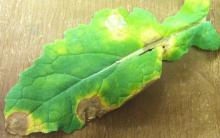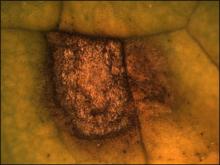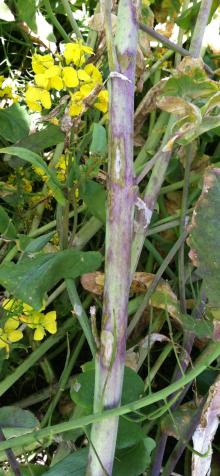By C. M. Ocamb
Cause The fungus, Neopseudocercosporella capsellae (formerly Pseudocercosporella capsellae, sexual stage: Mycosphaerella capsellae), has been observed in various Brassica seed crops in Oregon. It has been reported in oilseed rape in the United Kingdom and Canada. Pod losses of 15% have been reported in Europe. Turnip, Chinese cabbage, mustards and oilseed rape are thought to be more susceptible than cabbage, cauliflower, broccoli and other vegetable Brassica species. Horseradish and radish are susceptible to white leaf spot as well as weedy types such as wild radish, wild mustard, and shepherd's purse. Turnip seed fields have had severe disease outbreaks in western Oregon, but severity will depend on weather and disease management practices.
The fungus survives via the sexual stage or as dense mycelium on infected plant residues; in some regions, the sexual stage that results in ascospores is absent. Ascospores develop on infected Brassica or Raphanus residues during the autumn and possibly winter or spring months; these ascospores are wind-dispersed relatively long distances following rain or dew events. After a successful infection, asexual spores (conidia) subsequently develop in the leaf spots and are spread relatively short distances by rain or splashing water, causing secondary spread, including pod and seed infections. Seed transmission has not been reported to play a major role in disease outbreaks; infected crop residues are usually necessary for large-scale outbreaks, but seed transmission can lead to introduction of disease into new areas. Temperatures of 50°F to 60°F with moist conditions (rain, dew, or irrigation) promote disease development. Conidia can directly infect the plant or through stomata when ambient temperatures are between 46ºF and 82ºF (68ºF to 75ºF being optimum) and under moist conditions that provide 100% relative humidity and a minimum of eight hours of leaf wetness. Leaf spots are apparent after 6 to 8 days at 59ºF to 68ºF.
Symptoms This fungus can attack leaves, stems and pods. Tan, irregular or roundish spots develop on leaves, especially leaf tips and edges, later becoming ashy-gray to white with a brownish margin and sometimes a yellowish halo. White conidia can be observed on the underside of leaf spots. Leaf spots will become dark brown as leaves senesce, due to the initiation of the sexual stage. The center of older lesions may fall out, resulting in a shot hole appearance. Lesions may coalesce when disease is severe, resulting in defoliation. Stem lesions are elongated and first brown, turning ashy-gray to white with a brownish margin and numerous tiny dark specks due to the formation of the sexual stage; there is a distinct boundary between diseased and healthy tissue on the stem. Gray stem lesions are superficial; the pith is not severely infected. Pod infections are at first small brown spots that expand and turn grayish-white with numerous tiny dark specks due to the formation of the sexual stage.
Cultural control
- Rotate out of crucifers for 3 years.
- Control susceptible weeds and volunteer Brassica and Raphanus plants during rotations.
- Avoid planting in or adjacent to a field infected the previous season.
- Remove plant debris or bury by deep-plowing. Flailing followed by a shallow incorporation may be sufficient depending on amount and size of plant debris as well as environmental conditions.
Chemical control
- Plant seed treated with a fungicide:
- Coronet fungicide seed treatment (Group 7 + 11) at 5.1 to 6.2 fl oz/100 lb seed (commercial seed treaters only) plus a dye.
- Mertect 340-F (Group 1) at 3.5 fl oz in an equal amount of water (1:1)/100 lb of seed is registered for use on other diseases and may help with this pathogen. For seed production fields in Oregon only (SLN OR-100014).
- Rovral 4F (Group 2) at 16 fl oz/100 lb seed as a slurry by commercial seed treaters only. For seed production fields in Oregon (SLN OR-140013) and Washington (SLN WA-160007) only.
- Priaxor Xemium Brand (Group 7 + 11) at 6 to 8.2 fl oz/A is labeled for leafy brassicas and can be used for those seed crops produced in Oregon only. Do not make more than one (1) application of any Group 11 fungicide before alternating to a labeled fungicide with a different mode of action. Preharvest interval is 3 days. 12-hr reentry.
- Proline 480 SC (Group 3) at 5 to 5.7 fl oz/A is labeled for other diseases of brassicas and can be used to control white leaf spot in Oregon only; apply in the fall as wet weather get under way. For seed crops only in Oregon only (SLN OR-150017). No more than three (3) applications per year with a minimum 30-day interval between applications. Do not windrow within 14 days of last application. Preharvest interval is 14 days. 12-hr reentry.
- Quadris Flowable (Group 11) at 6 to 15.5 fl oz/A on 7- to 14-day intervals or Quadris Top (Group 11 + 3) at 12 to 14 fl oz/A are labeled for certain brassicas and can be used for those seed crops produced in Oregon only. An additive such as crop-oil concentrate or non-ionic surfactant may be used. Do not apply more than one (1) foliar application of Quadris per season. Preharvest interval is 0 day for Quadris Flowable and 1 day for Quadris Top. 4-hr reentry for Quadris Flowable, 12-hr reentry for Quadris Top.
Reference Inman, A.J., and Fitt, B.D.L. 2007. Whites Leaf Spot. p. 50-54 in Compendium of Brassica Diseases. Rimmer, S.R., Shattuck, V.I., and Buchwaldt, L. (eds.). St. Paul, MN: APS Press.
Inman, A.J., Fitt, B.D.L., Todd, A.D., and Evans, R.L. 1999. Ascospores as primary inoculum for epidemics of white leaf spot (Mycosphaerella capsellae) in winter oilseed rape in the UK. Plant Pathol. 48:308-319.
Inman, A.J., Fitt, B.D.L., Welham, S.J., Evans, R.L., and Murray, D.A. 1997. Effects of temperature, cultivar, and isolate on the incubation period of white leaf spot (Mycosphaerella capsellae) on oilseed rape in the UK. Ann. Appl. Biol. 130:239-253.




